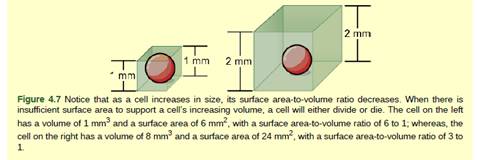
Concept explainers
Figure 4.7 Prokaryotic cells are much smaller than eukaryotic cells. What advantages might small cell size confer on a cell? What advantages might large cell size have?

To analyze:
Prokaryotic cells are much smaller than the eukaryotic cells. Discuss the advantages a small cell size and a large cell size confer on a cell.
Introduction:
A small cell size allows quick transport of molecules. A large cell size helps to separate biological process and support the synthesis of complex molecules.
Explanation of Solution
A small cell size has several advantages. It allows an easy transport of substances across the plasma membrane. Small cells have a higher surface area to volume ratio, which provide them a greater surface area for the exchange of nutrients and waste materials by spending relatively lesser energy. In a small cell, nucleus is relatively closer to the plasma membrane. This results in an efficient transport of messages.
Large cell size has its own share of advantages. It allows to be divided into compartments. Large cells have organelles. Different organelles perform different functions thus enabling the cell to build molecules that are more complex in nature.
A small cell size allows an easier transport of substance through the plasma membrane by spending a relatively lesser amount of energy. A large cell size allows to be divided into compartments. Different organelles perform different functions thereby enabling the cell to produce complex molecules.
Want to see more full solutions like this?
Chapter 4 Solutions
Biology 2e
Additional Science Textbook Solutions
College Physics
Biological Science
Campbell Essential Biology with Physiology (6th Edition)
Biology: Life on Earth (11th Edition)
Fundamentals of Anatomy & Physiology (11th Edition)
Biology: Life on Earth with Physiology (11th Edition)
- The eukaryotic cell in the photo on the left is in the process of cytoplasmic division. Is this cell from a plant or an animal? How do you know?arrow_forwardFigure 3.13 Why does the cis face of the Golgi not face the plasma membrane?arrow_forwardUnlike eukaryotic cells, prokaryotic cells ________. a. have no plasma membrane b. have RNA but not DNA c. have no nucleus d. a and carrow_forward
- A typical prokaryotic cell ________ compared to a eukaryotic cell. a. is smaller in size by a factor of 100 b. is similar in size c. is smaller in size by a factor of one million d. is larger in size by a factor of 10arrow_forwardWhich of the following is found both in eukaryotic and prokaryotic cells? a. nucleus b. mitochondrion c. vacuole d. ribosomearrow_forwardWhy is the relationship between surface area and volume of a cell important in determining cell size limits?arrow_forward
- A prokaryote converts food energy into the chemical energy of ATP on/in its: chromosome. flagella. ribosomes. cell wall. plasma membrane.arrow_forwardThe surface-to-volume ratio _______. a. does not apply to prokaryotic cells. b. constrains cell size. c. is part of the cell bodyarrow_forwardThe plasma membrane __________. a. surrounds the cytoplasm b. separates the nucleus from the cytoplasm c. separates the cell interior from the environment d. both a and carrow_forward
- Which of the following is not a component of the endomembrane system? a. mitochondrion b. Golgi apparatus c. endoplasmic reticulum d. Iysosomearrow_forwardWhy is it advantageous for the cell membrane to be fluid in nature?arrow_forwardIn the context of cell biology, what do we mean by form follows function? What are a least two examples of this concept?arrow_forward
 Biology 2eBiologyISBN:9781947172517Author:Matthew Douglas, Jung Choi, Mary Ann ClarkPublisher:OpenStax
Biology 2eBiologyISBN:9781947172517Author:Matthew Douglas, Jung Choi, Mary Ann ClarkPublisher:OpenStax Concepts of BiologyBiologyISBN:9781938168116Author:Samantha Fowler, Rebecca Roush, James WisePublisher:OpenStax College
Concepts of BiologyBiologyISBN:9781938168116Author:Samantha Fowler, Rebecca Roush, James WisePublisher:OpenStax College Biology Today and Tomorrow without Physiology (Mi...BiologyISBN:9781305117396Author:Cecie Starr, Christine Evers, Lisa StarrPublisher:Cengage Learning
Biology Today and Tomorrow without Physiology (Mi...BiologyISBN:9781305117396Author:Cecie Starr, Christine Evers, Lisa StarrPublisher:Cengage Learning
 Human Biology (MindTap Course List)BiologyISBN:9781305112100Author:Cecie Starr, Beverly McMillanPublisher:Cengage Learning
Human Biology (MindTap Course List)BiologyISBN:9781305112100Author:Cecie Starr, Beverly McMillanPublisher:Cengage Learning Biology: The Unity and Diversity of Life (MindTap...BiologyISBN:9781305073951Author:Cecie Starr, Ralph Taggart, Christine Evers, Lisa StarrPublisher:Cengage Learning
Biology: The Unity and Diversity of Life (MindTap...BiologyISBN:9781305073951Author:Cecie Starr, Ralph Taggart, Christine Evers, Lisa StarrPublisher:Cengage Learning





